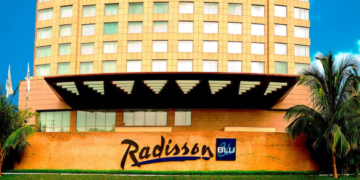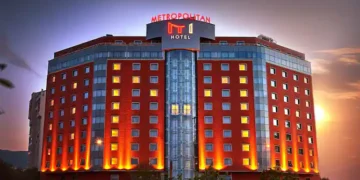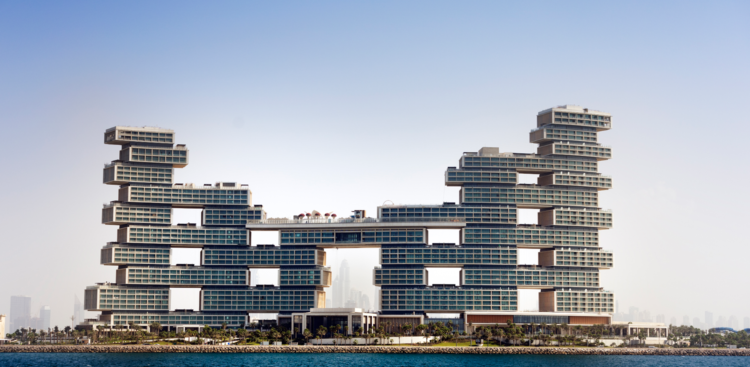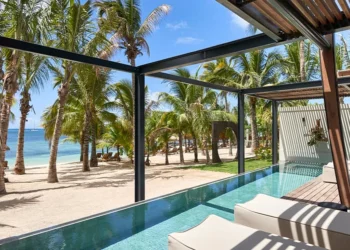Table of Contents:
1. Introduction
2. Minimalist Hotel Designs
3. Luxury Hotel Designs
4. Wellness-Focused Hotel Designs
5. Smart Hotel Room Designs
6. AI in Hospitality
7. Contactless Hotel Experiences
8. Mobile Keyless Entry
9. Voice-Activated Assistants in Hotel Rooms
10. Hyper-Local Guest Experiences
11. Collaborative and Co-Working Spaces
12. Smart Lighting and Energy-Saving Systems
13. Customised Interiors
14. Transparent Designs
15. Solar Power Technology in Architecture
16. 3D Printing in Architecture
17. Conclusion
18. FAQs
Introduction:
The hospitality industry has been evolving rapidly over the years, and so have the expectations of guests. With the introduction of new technology and innovative designs, the future of hotel design is set to change dramatically. This article will explore some of the latest trends and advancements in hotel design and how they are set to shape the future of the hospitality industry.

Minimalist Hotel Designs
In recent years, the design movement of minimalism has been increasingly fashionable. It is distinguished by simplicity, usability, and an emphasis on crucial components. Clean lines, neutral hues, and uncluttered areas are the hallmarks of minimalism in hotel design. Visitors seeking a serene and soothing ambiance will love this design aesthetic.
Luxury Hotel Designs
Luxury hotels have always been associated with opulence and grandeur. However, the definition of luxury is changing. Today, luxury is all about personalized experiences, high-end amenities, and exceptional service. In hotel design, this means creating spaces that are not just beautiful but also functional and comfortable.
Wellness-Focused Hotel Designs
Wellness has become a significant trend in the hospitality industry. Today, more and more guests are looking for hotels that promote health and wellbeing. In hotel design, this translates into spaces that are designed to reduce stress, promote relaxation, and encourage healthy habits.
Smart Hotel Room Designs
Smart hotel room design is all about creating spaces that are technologically advanced and intuitive. This includes features such as mobile keyless entry, voice-activated assistants, and smart lighting systems. These features not only make the guest experience more convenient but also provide opportunities for hotels to save on energy costs.
AI in Hospitality
Artificial Intelligence (AI) is set to revolutionize the hospitality industry. AI-powered chatbots and voice assistants are already being used to provide guests with personalized recommendations and assistance. In the future, AI is expected to be used for everything from guest room cleaning to predicting guest preferences.

Contactless Hotel Experiences
Contactless experiences have become more important in the wake of the COVID-19 pandemic. This includes everything from contactless check-in to contactless room service. These experiences not only provide a safer environment for guests but also create opportunities for hotels to reduce operational costs.
Mobile Keyless Entry
Mobile keyless entry is a feature that allows guests to use their mobile devices to unlock their hotel rooms. This technology not only provides guests with a more convenient experience but also eliminates the need for physical keys, which can be lost or stolen.
Voice-Activated Assistants in Hotel Rooms
Voice-activated assistants are becoming increasingly popular in hotel rooms. These assistants can perform tasks such as turning on the lights, adjusting the temperature, and playing music. This technology not only provides guests with a more convenient experience but also creates opportunities for hotels to improve their operations.
Hyper-Local Guest Experiences
Hyper-local design has become increasingly popular in recent years, and it’s no surprise that hotels are beginning to incorporate this trend into their designs. Hyper-local guest experiences involve creating a hotel environment that reflects the local community and culture, which can help to create a more immersive and authentic experience for guests.
For example, hotels might incorporate local artwork, use locally-sourced materials and furnishings, or offer locally-inspired cuisine. This trend not only helps hotels to stand out from the competition, but it also supports local businesses and communities.
Collaborative and Co-Working Spaces
Another trend that is becoming increasingly popular is the inclusion of collaborative and co-working spaces within hotels. As remote work becomes more common, many travellers are looking for spaces where they can work and collaborate with others while on the road.
Hotels are responding to this trend by incorporating dedicated co-working spaces within their properties. These spaces often include high-speed internet, comfortable seating, and other amenities such as printing and scanning facilities. Some hotels even offer private meeting rooms for business travellers who need to host meetings or presentations.
Smart Lighting and Energy-Saving Systems
As sustainability becomes increasingly important to travellers, hotels are exploring new ways to reduce their environmental impact. One way they are doing this is by incorporating smart lighting and energy-saving systems into their designs.
Smart lighting systems can automatically adjust lighting levels based on occupancy and time of day, while energy-saving systems can help to reduce energy consumption by automatically adjusting temperature and air conditioning settings. These technologies not only help hotels to reduce their environmental impact but can also lead to significant cost savings over time.
Customised Interiors
Gone are the days of cookie-cutter hotel room designs. Today’s travellers are looking for unique and personalised experiences, and hotels are responding by incorporating customised interiors into their designs.
This trend involves designing hotel rooms and common areas that are tailored to the specific needs and preferences of individual guests. For example, some hotels offer guests a choice of pillows or bedding based on their preferences, while others allow guests to choose from a selection of room layouts and configurations.
Transparent Designs
Another trend that is gaining popularity in the hotel industry is transparent design. This involves incorporating elements of transparency and openness into hotel designs, such as glass walls or open floor plans.
In addition to giving a space a more contemporary and streamlined appearance, transparent design can foster an atmosphere of openness and connection between visitors and their surroundings. Beautiful vistas and abundant natural light are common features of hotels with transparent design elements, which can contribute to a more restful and revitalising environment for visitors.
Solar Power Technology in Architecture
As the world looks for ways to reduce its reliance on fossil fuels, hotels are exploring new ways to incorporate renewable energy into their designs. One technology that is becoming increasingly popular is solar power.
Solar power technology can be incorporated into hotel designs in a variety of ways, from rooftop solar panels to integrated solar shading systems. Hotels that incorporate solar power technology not only reduce their carbon footprint, but they can also save money on energy costs over time.
3D Printing in Architecture
Another technology that is transforming the hotel industry is 3D printing. 3D printing allows designers to create intricate and complex designs quickly and easily, which can help to speed up the construction process and reduce costs.
In the hotel industry, 3D printing is being used to create everything from custom furnishings to entire hotel rooms. This technology allows designers to create highly unique and personalised spaces that stand out from the competition.
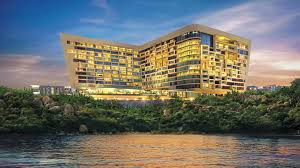
Conclusion:
The future of hotel design is all about innovation. From minimalist and luxury designs to wellness-focused and smart room designs, hotels are adopting new technologies and strategies to enhance the guest experience. This includes the use of AI, contactless experiences, and hyper-local designs that reflect the local culture and environment. It also involves the use of sustainable and energy-efficient materials and technologies, as well as artistic and personalised designs that offer guests a truly unique experience.
As the world continues to evolve, so too will the hotel industry. With new technologies, materials, and design trends emerging all the time, hotels will need to be adaptable and flexible in their approach to stay ahead of the curve. By embracing these trends and incorporating them into their designs, hotels can ensure that they remain relevant, innovative, and desirable for guests in the years to come.
FAQs:
What is a wellness-focused hotel?
- A wellness-focused hotel is one that offers a range of amenities and services that promote relaxation, rejuvenation, and overall wellbeing. These may include spas, fitness centres, and healthy food options.
What is a smart hotel room design?
- A smart hotel room design incorporates technology to enhance the guest experience, such as mobile keyless entry, voice-activated assistants, and smart lighting and energy-saving systems.
What are some examples of hyper-local guest experiences?
- Hyper-local guest experiences may include tours of the local area, visits to local markets or restaurants, or participation in local cultural events or activities.
What are building automation systems?
- Building automation systems are technology systems that control and monitor a building’s various systems and functions, such as lighting, heating, and air conditioning.
What are some benefits of using sustainable building materials in hotel design?
- Using sustainable building materials can help reduce a hotel’s environmental impact and improve its energy efficiency, leading to cost savings and a more eco-friendly reputation.
What is a boutique hotel?
- A boutique hotel is a small, stylish hotel that offers a personalised, intimate experience to guests. They often have unique, artistic designs and offer bespoke services tailored to individual guests’ needs and preferences.





